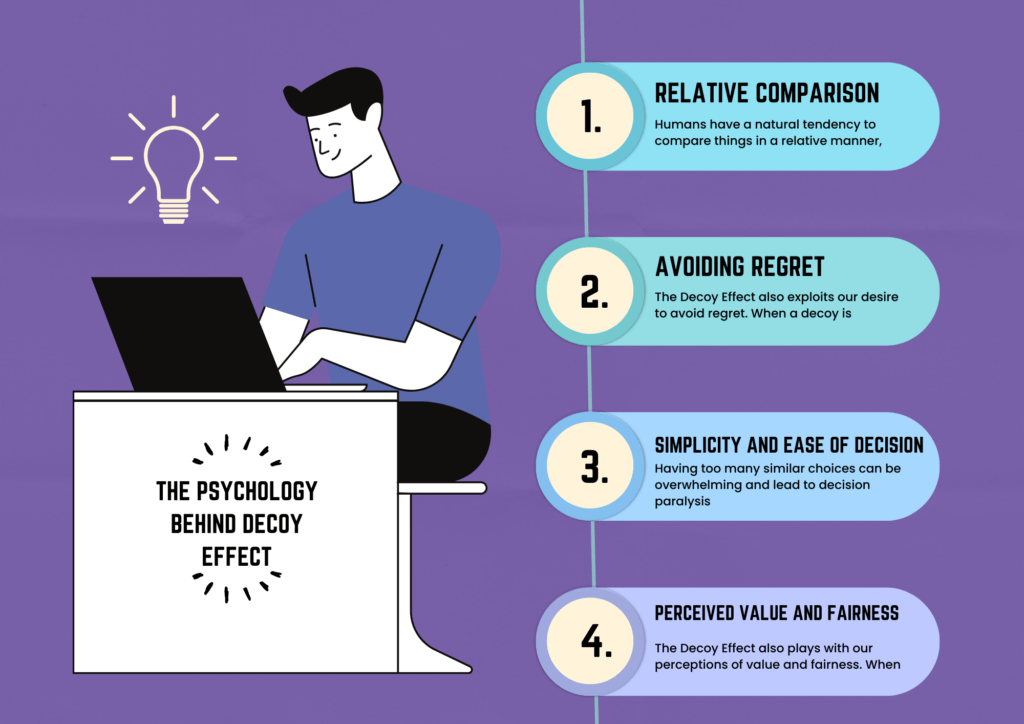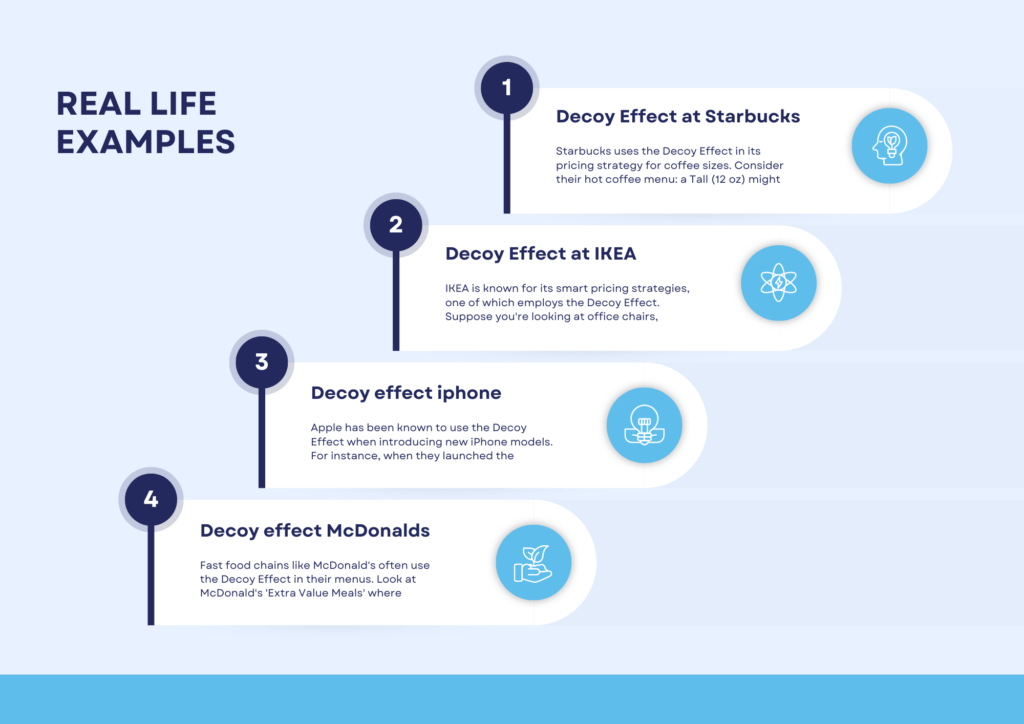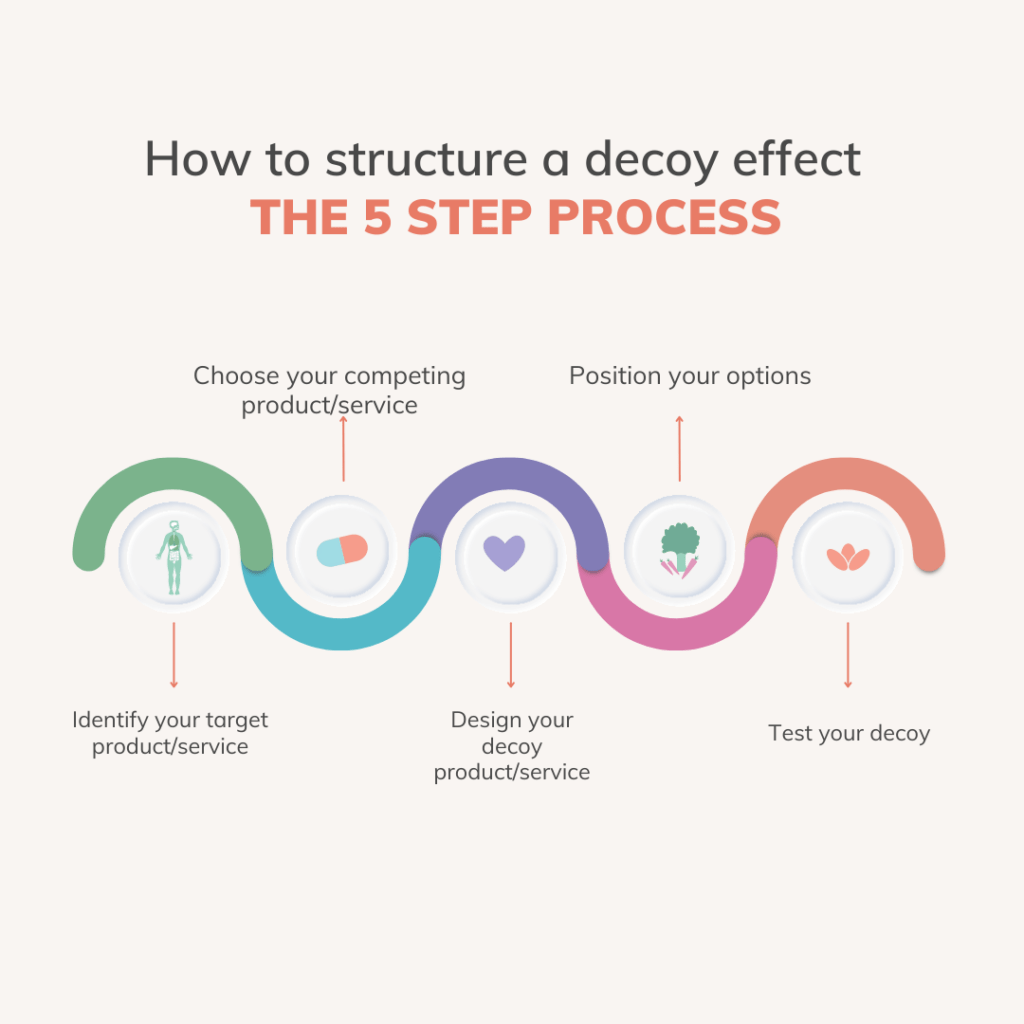Dive into the Decoy Effect, the psychological phenomenon shaping our purchasing choices. Learn its impact on marketing and how it influences your everyday decisions.
Introduction
Have you ever wondered why you sometimes buy things that you don’t really need or why you pick one item over another? What if I told you there’s a secret trick that companies use to steer your choices? This trick is called the ‘Decoy Effect’. It’s like a hidden guiding hand that softly pushes you towards making certain choices, without you even noticing it.
Join us as we go on a fun adventure to discover more about this Decoy Effect. You’ll get to understand why you make certain decisions and if you’re really in control or just being cleverly guided. By the end of our journey, you might start seeing things like menus and sales adverts in a whole new light! So, are you ready to uncover the hidden truths about your choices?
What is Decoy Effect
The Decoy Effect is a trick that our brains play on us when we’re trying to decide between a few options. Imagine you’re looking at two TV sets in a store. One is big and cheap but has low quality, and the other one is small and expensive but of very high quality. You’re not sure which one to choose.
But then, the salesman shows you a third TV. This one is big and of high quality but it’s very, very expensive. Now, the second TV (small and expensive, but high quality) doesn’t seem too bad, right? Even though it’s smaller than the first TV, it’s better quality and not as expensive as the third one. So, you decide to buy the second TV.
That’s the Decoy Effect! The third TV was the ‘decoy’ because it was only there to make the second TV look more appealing. It’s a clever trick that businesses use to make you buy what they want you to buy, and you won’t even realize it’s happening. Pretty fascinating, right?
Decoy Effect Definition
The Decoy Effect is a psychological trick that companies use to influence your decision-making. When given several options, they introduce a ‘decoy’ – an option designed to be unattractive – that makes another option look more appealing. This causes you to lean towards the option they want you to choose.
According to the Journal of Marketing Research, the Decoy Effect, also known as the “asymmetrical dominance effect,” is a phenomenon whereby consumers change their preference between two options when presented with a third option that is asymmetrically dominated (Huber, Payne, and Puto, 1982). An option is asymmetrically dominated when it is inferior in all respects to one option, but only in some respects to the other. This inferior option is the ‘decoy’ that makes the superior option seem more attractive.
Behavioral economist Dan Ariely defines the Decoy Effect as a situation in which an individual’s preference for a particular option changes as a result of the introduction of an additional, less attractive option. This decoy option is not meant to be chosen, but rather to nudge individuals towards a particular choice that is in the interest of the decision architect.
The Psychology behind Decoy Effect
The Decoy Effect taps into a few fascinating aspects of human psychology related to how we perceive value and make decisions.

Relative Comparison: Humans have a natural tendency to compare things in a relative manner, rather than in absolute terms. We don’t just consider the value of things on their own, but also how they stack up against other similar options. When a decoy is introduced, it creates a clear point of comparison that makes one of the other options look better. The decoy is usually clearly inferior to one option (the target), making the target look like a more attractive choice.
Avoiding Regret: The Decoy Effect also exploits our desire to avoid regret. When a decoy is present, the target option not only looks better by comparison, but also appears to be a safe choice. Choosing an option that seems clearly better than another can help minimize feelings of regret about making a ‘wrong’ decision.
Simplicity and Ease of Decision: Having too many similar choices can be overwhelming and lead to decision paralysis. But the presence of a decoy simplifies the decision-making process. Since the decoy is clearly inferior to the target, it makes the target look like the obvious choice. This eases the cognitive load of making a decision, and we’re more likely to go with the option that seems simple and clear.
Perceived Value and Fairness: The Decoy Effect also plays with our perceptions of value and fairness. When there’s a clearly inferior option (the decoy), it makes the target seem like a ‘fair deal’ — we feel like we’re getting good value for our money, even if we’re actually spending more than we originally intended.
The History of Decoy Effect
The Decoy Effect is an observation in the field of behavioral economics and has its roots in academic research from the 1980s. While the phenomenon may have been subtly influencing consumer behavior for much longer, it wasn’t formally identified and studied until relatively recently in the history of economic theory.
The Decoy Effect was first named and scientifically described by scholars Joel Huber, John Payne, and Christopher Puto in their 1982 study titled “Adding Asymmetrically Dominated Alternatives: Violations of Regularity and the Similarity Hypothesis”. In this research, the authors performed experiments in which they presented participants with choices and observed how adding a decoy option could shift preferences.
Their findings were surprising and somewhat counterintuitive based on traditional economic theory, which assumes rational decision-making. The introduction of an additional, but clearly inferior, option shouldn’t theoretically change people’s preferences between the original options. Yet, their experiments showed it did – a result they called the “asymmetrical dominance effect”, which would later become more commonly known as the Decoy Effect.
In the following years, this area of study was further developed by economists and psychologists who were interested in how people make decisions. The work of behavioral economists such as Daniel Kahneman, Amos Tversky, and Dan Ariely built on this early research. They not only confirmed the existence of the Decoy Effect but also further explored the various biases and heuristics that guide human decision-making.
The Decoy Effect has now become a well-established concept in the fields of marketing, economics, and psychology. It’s used by companies worldwide to influence consumer behavior and continues to be a topic of academic research and debate.
Decoy Effect Examples

Decoy effect in marketing
In marketing, the Decoy Effect is used to steer customers towards a particular product or service. For example, a company may offer three subscription packages: a basic package, an expensive premium package, and a mid-range package that is only slightly more expensive than the basic one but offers much more value. Here, the expensive premium package acts as the decoy, making the mid-range package seem like a great deal. Customers are more likely to choose the mid-range package, which they might not have done if the premium package hadn’t been there for comparison.
Decoy Effect in Pricing
In pricing, businesses may introduce a decoy product that is priced higher than the product they want to sell more of. This makes the target product seem more affordable and attractive. For example, if a coffee shop sells a small coffee for $2, a medium coffee for $2.50, and a large coffee for $3.50, the large coffee serves as the decoy, making the medium coffee seem like the best value for money.
Decoy effect behavioral economics
In behavioral economics, the Decoy Effect is a deviation from the economic principle of rational choice. Traditional economics suggests that adding an inferior option (the decoy) should not change people’s preferences between the other options. But the Decoy Effect demonstrates that people’s choices can be swayed by the presence of the decoy, showing that decision-making isn’t always rational and can be influenced by how choices are presented.
Decoy Effect in relationships
Interestingly, the Decoy Effect can also occur in social situations like dating. For example, someone might seem more attractive if they’re standing next to someone less attractive (the decoy). Or a person might appear more desirable as a partner if there’s a less appealing ‘decoy’ person who makes them seem like a better ‘deal’ by comparison.
Decoy Effect in Politics
In politics, the Decoy Effect can be used in voting systems or during political campaigns. A candidate or a political party might introduce ‘decoy’ issues or candidates to shift public opinion or votes in their favor. For example, by focusing on a less important but divisive issue (the decoy), a politician can make their stance on a more critical issue seem more appealing. Voters might then be swayed to choose that politician, influenced by the presence of the decoy.
Real Life Examples

Decoy Effect at Starbucks
Starbucks uses the Decoy Effect in its pricing strategy for coffee sizes. Consider their hot coffee menu: a Tall (12 oz) might be priced at $1.95, a Grande (16 oz) at $2.15, and a Venti (20 oz) at $2.35. Most customers will see the small difference in price between a Grande and a Venti, despite the Venti being significantly larger, and feel inclined to choose the Venti. Here, the Tall size acts as a decoy to make the Venti appear as a better deal than the Grande.
Decoy Effect at IKEA
IKEA is known for its smart pricing strategies, one of which employs the Decoy Effect. Suppose you’re looking at office chairs, you might find a basic chair for $50, a more comfortable and adjustable chair for $150, and then a very similar chair to the $150 one, but priced at $200. The $200 chair doesn’t offer much more than the $150 chair, which makes the latter appear as a more attractive deal. The $200 chair acts as a decoy to push customers towards buying the $150 chair.
Decoy effect iphone
Apple has been known to use the Decoy Effect when introducing new iPhone models. For instance, when they launched the iPhone 8, iPhone 8 Plus, and iPhone X, the iPhone 8 Plus served as a decoy. The iPhone 8 was the basic model, the iPhone X was the top model with the highest price, and the iPhone 8 Plus had a price and features that sat in between the other two models. The presence of the iPhone 8 Plus made the high price of the iPhone X seem more reasonable, nudging customers towards the more expensive option.
Decoy effect McDonalds
Fast food chains like McDonald’s often use the Decoy Effect in their menus. Look at McDonald’s ‘Extra Value Meals’ where a burger costs $4, fries $2, and a drink $1, but the combo of all three is $6. Separately, they cost $7, making the combo meal seem like a great deal. But what if you don’t want the fries? You’d be more likely to buy them anyway because they seem ‘free’ or ‘cheaper’ in the combo. Here, the individual items act as decoys to make the combo meal seem like better value.
Comparisons
Compromise effect vs decoy effect
The Compromise Effect and Decoy Effect are both strategies that can influence consumer choice, but they work in slightly different ways.
The Compromise Effect is the tendency for consumers to avoid extremes and instead go for a middle-of-the-road option. For instance, if there are three TVs to choose from – one that is cheap with few features, one that is expensive with many features, and one that is moderately priced with a moderate number of features – people are more likely to choose the middle option because it’s a safe, balanced choice.
On the other hand, the Decoy Effect occurs when an additional, less attractive option (the decoy) is introduced, which makes one of the other options more appealing by comparison. For example, if a fourth TV is introduced that is more expensive than all the others but has fewer features than the most expensive one, this could make the previously most expensive TV seem more attractive.
Asymmetric dominance vs decoy effect
The terms Asymmetric Dominance and Decoy Effect essentially refer to the same phenomenon. Asymmetric Dominance is the more formal term used in academia. It refers to a situation where one option (the target) is clearly superior to another option (the decoy) in some respects, and at least as good in all other respects.
The Decoy Effect, a more casual term often used in marketing and popular discussions, describes the effect this situation has on people’s decision-making. When faced with a choice between several options, people are more likely to choose the target option if a decoy option is present. The decoy is ‘dominated’ by the target (i.e., it’s clearly inferior), which makes the target seem more attractive by comparison.
How to structure a decoy effect: The 5 Step Process

Identify your target product/service: This is the option you want consumers to select. It should be reasonably priced and offer good value for money in terms of features or benefits.
Choose your competing product/service: This option is typically less expensive than the target but offers fewer benefits. The purpose of this option is to establish a baseline for comparison.
Design your decoy product/service: The decoy should be priced similarly to the target or even slightly higher. However, the features or benefits it offers should clearly be inferior to those of the target. The decoy should be similar enough to be comparable to the target, but inferior enough to make the target look more attractive. This is the key to the Decoy Effect.
Position your options: When presenting the options to consumers, make sure all of them are clearly visible and comparable. The consumer should be able to easily see the differences in price and features.
Test your decoy: Before rolling it out completely, it’s a good idea to test the effectiveness of your decoy in a controlled environment or with a smaller segment of your audience. This will help you ensure that the decoy is having the desired effect and not unintentionally driving customers towards the cheaper option or causing decision paralysis.
Remember, the goal is not for the decoy to be chosen, but rather to make the target option appear more attractive. The success of the Decoy Effect relies heavily on careful structuring and presentation of the options.
Decoy Effect: Advantages and Disadvantages
Advantages of the Decoy Effect
Boosts Sales: The Decoy Effect can increase sales of a specific product or service by making it seem more valuable compared to the decoy option. This can result in higher overall revenue for businesses.
Steers Consumer Choices: Businesses can use the Decoy Effect to guide consumers towards options that are more profitable. By strategically placing decoy options, companies can influence consumers’ perception of value and steer their choices.
Value Perception: It can enhance customers’ perception of the value they’re getting, thereby increasing customer satisfaction. If customers feel like they’ve snagged a deal, they’ll likely have a more positive impression of the company.
Differentiation: The Decoy Effect can help highlight the unique features and benefits of a product or service. When consumers compare the target and the decoy, the superior aspects of the target are emphasized.
Disadvantages of the Decoy Effect
Potential Backfire: If not carefully designed, the decoy could either make the cheaper option seem more attractive or cause decision paralysis among consumers. This could lead to lost sales or dissatisfaction.
Overuse: If used too often, consumers may catch on to this strategy, which could harm the company’s reputation and lead to skepticism among consumers.
Temporary Impact: The Decoy Effect can be short-lived once consumers make a purchase and evaluate their satisfaction with it. If they feel they didn’t get the value they expected, they may become dissatisfied and less likely to fall for the same trick again.
Ethical Concerns: Some critics argue that using the Decoy Effect can be manipulative, as it’s designed to steer customers towards making a particular choice. Companies must therefore ensure they’re using this strategy ethically.
Samrat is a Delhi-based MBA from the Indian Institute of Management. He is a Strategy, AI, and Marketing Enthusiast and passionately writes about core and emerging topics in Management studies. Reach out to his LinkedIn for a discussion or follow his Quora Page
